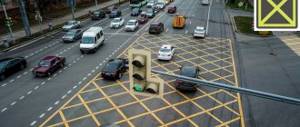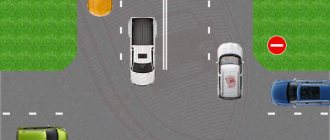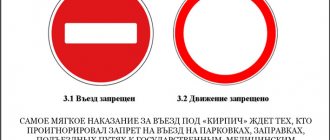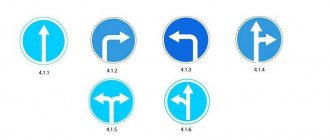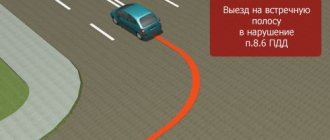1. Driving to an intersection or crossing a roadway in the event of a traffic jam that has forced the driver to stop, creating an obstacle to the movement of vehicles in the transverse direction, shall entail the imposition of an administrative fine in the amount of one thousand rubles.
(Paragraph as amended, put into effect on January 1, 2012 by Federal Law of April 21, 2011 N 69-FZ.
2. Failure to comply with the requirement of the Traffic Rules to give way to a vehicle enjoying priority right of passage through intersections shall entail the imposition of an administrative fine in the amount of one thousand rubles.
(Paragraph as amended by Federal Law of June 22, 2007 No. 116-FZ; as amended by Federal Law of April 21, 2011 No. 69-FZ.
What is the penalty for violating traffic rules?
In big cities, violating the rules of driving through intersections is not uncommon. But this does not mean that it is possible to do so. When entering an intersection, it is worth assessing the situation with utmost attention - if the driver behaves incorrectly, he cannot leave it and creates a problem for traffic flows. If you drive through intersections incorrectly, a fine will be imposed according to Article 12.13 of the Code of Administrative Offenses.
In the Rules, an intersection is considered to be an area where roads located at the same level intersect, adjoin each other or branch. The area should be limited by imaginary lines that connect the starting points of the curvature of the roadways, most distant from the middle of the intersection.
Departure in case of congestion
According to Article 12.13 of the Administrative Code , attempting to enter an intersection in the event of a traffic jam directly behind it constitutes an administrative offense and is punishable by a fine of 1,000 rubles. The driver's behavior in this situation is specified in the traffic rules very clearly. You can read more about traffic police fines in the amount of 1000 rubles in this material.
When trying to enter a road intersection, not paying attention to the fact that there is a whole line of cars standing outside, the offender gets stuck in the most inconvenient place on the road. It is precisely where he will be forced to stop the vehicle that an increased danger for the offender is expected; in addition, in this case it becomes an obstacle to the movement of cars from other directions.
It is also worth remembering that as of April 28, 2018, a new road sign and horizontal markings for intersections appeared:
- 1.26 - the so-called “waffle” horizontal marking, prohibiting crossing in case of congestion at the intersection;
- 1.35 — sign “Crossroads section”. Placed at the border of the intersection.
Horizontal marking 1.26
Sign 1.35 “Intersection Section”
What happens if you don’t give way to another car?
When driving through intersections, you must give way to cars approaching from the right , if we are talking about an unregulated option. If a car, which in this situation will have the right of way, cannot pass due to the driver’s reluctance to let it through to perform the maneuver, the violator will face a fine of 1,000 rubles (Article 12.13 of the Administrative Code).
Reversing
Important! At intersections, the vehicle driver is prohibited from driving in reverse.
The ban is associated with the increased danger of any maneuvers on these sections of roads. For violating the rules of maneuvering, a fine of 500 rubles is imposed (more details about traffic police fines in the amount of 500 rubles can be found here).
It is worth remembering that when trying to move in this way at a road intersection, if the driver has passed the entrance to the yard, the maneuver will be considered permitted. The traffic rules indicate that leaving the yard does not fall into the category of intersections .
Judicial practice under Article 12.13 of the Code of Administrative Offenses of the Russian Federation:
Decision of the Supreme Court: Resolution No. 67-AD13-9 of October 31, 2013 Judicial Collegium for Administrative Cases, supervision
Supreme Court decision: Resolution No. 29-AD14-3 of June 16, 2014 Judicial Collegium for Administrative Cases, supervision
Supreme Court decision: Resolution No. 25-AD10-15 of January 27, 2011 Judicial Collegium for Administrative Cases, supervision
Supreme Court decision: Resolution No. 24-AD11-1 of 03/05/2011 Judicial Collegium for Administrative Cases, supervision
Supreme Court decision: Resolution N 78-AD15-4 of September 18, 2015 Judicial Collegium for Administrative Cases, supervision
Supreme Court decision: Resolution N 37-AD15-6 dated 12/02/2015 Judicial Collegium for Administrative Cases, supervision
Supreme Court decision: Resolution No. 16-AD10-2 of 05/04/2010 Judicial Collegium for Administrative Cases, supervision
Supreme Court decision: Resolution N 59-AD13-6 of 02/06/2014 Judicial Collegium for Administrative Cases, supervision
Supreme Court decision: Resolution N 74-AD11-5 of July 25, 2011 Judicial Collegium for Administrative Cases, supervision
Decision of the Supreme Court: Resolution No. 16-AD10-1 of March 26, 2010 Judicial Collegium for Administrative Cases, supervision
- First
- «
- Last
Comments ()
Write a comment
The concepts of equivalent and unequal
By ignoring traffic regulations, motorists interfere with all vehicles in the neighborhood. Therefore, it is worth not just familiarizing yourself with the established provisions once, but also making it a rule to repeat them from time to time. When driving through such intersections, it is recommended to maintain distance. The optimal value is considered to be 50 meters - this allows even inexperienced drivers to assess the situation in advance and make the right decision.
Unregulated
At controlled intersections, traffic is carried out in accordance with the traffic lights or those given by the traffic controller (more information about driving through a prohibitory traffic light can be found in this material). In case of a controversial situation, the signals given by the regulators will have priority.
Vehicles can travel in directions permitted by a traffic controller or a special green signal. When turning left, the driver lets through all vehicles that are going to drive in the straight direction or turn right.
When driving through road intersections where there are no traffic lights or traffic controllers, you should use the right-hand rule. According to clause 11 of article 13 of the traffic rules, drivers of trackless vehicles must give way to everyone driving from the right side of an equivalent intersection. The same rule applies to tram drivers. When moving to the left or making a U-turn, you should give way to cars and trams that are traveling on an equivalent road from the opposite direction to the right or straight (clause 12, article 13).
When approaching an unregulated intersection on a secondary road, a motorist allows everyone driving on the main road to pass. Those driving along the main road use the right-hand rule to establish queues.
Circular
Intersections with roundabout traffic are always unregulated. But they can be equivalent or unequal. It is worth remembering that cars driving in a circle are automatically considered to be on the main road. When driving through an unequal roundabout intersection, follow the signs.
Attention! A driver entering such an intersection must always turn on the right turn signal. It is turned on before leaving. You can enter the intersection from any of the lanes, but you must exit from the right.
Tram rails
Clause 6 of Article 13 of the Traffic Regulations states that the tram will always have the right of way over trackless vehicles . Exceptions are when a tram leaves a depot, moves to a switch in an additional section of a traffic light, or approaches an intersection of roads with a secondary one.
In general, intersections are sections of roads located at the same level, which can intersect each other, split into several parts, or converge at one point. According to the rules, you cannot enter an intersection if there is a traffic jam behind it (clause 2 of article 13 of the traffic rules). This concept is not deciphered in any way in the traffic rules. It is assumed that a traffic jam can be defined as several vehicles stopped on the road without violating the rules.
A classic traffic jam can be described as follows: it is several vehicles accumulated on the roadway, moving at extremely low speeds or even standing in one place. Its formation reduces the capacity of the road section. Congestion increases when other vehicles join it.
What mitigates responsibility?
A judge, body, or official considering a case when imposing a fine for violating the rules for crossing intersections may recognize the following circumstances as mitigating | Art. 4.2 Code of Administrative Offenses of the Russian Federation:
- repentance of the person who committed the administrative offense;
- voluntary cessation of unlawful behavior;
- voluntary reporting of an administrative offense committed;
- providing assistance to the body authorized to carry out proceedings in a case of an administrative offense in establishing the circumstances to be established in a case of an administrative offense;
- preventing harmful consequences of an administrative offense;
- voluntary compensation for damage caused or voluntary elimination of harm caused;
- voluntary execution, before a decision is made in a case of an administrative offense, of an order to eliminate the violation;
- committing an administrative offense in a state of strong emotional excitement (affect) or due to a combination of difficult personal or family circumstances;
- commission of an administrative offense by a minor;
- commission of an administrative offense by a pregnant woman or a woman with a young child;
- A judge, body, or official considering a case of an administrative offense may recognize other circumstances as mitigating.
Controversial situations
It is not uncommon for controversial situations that force traffic violations to occur due to improper traffic organization. For example, a main road sign may be placed at an exit from an adjacent area, but such a road crossing is not considered an intersection. A driver who has been misled and received a fine for an incorrect assessment of the situation is recommended to especially point out during the proceedings the fact that traffic on the road is organized incorrectly.
It is not uncommon for traffic police inspectors to try to mislead drivers by implying that they stopped incorrectly before passing through an intersection. Meanwhile, the driver is sure that he stopped exactly in front of the stop line and did not enter the intersection. Unless the violation was recorded using photos or video, try to prove that the stop was made correctly. In practice, the location of traffic police officers rarely makes it possible to accurately determine whether the car was stopped correctly.
Reference! To prove the guilt of drivers, traffic police inspectors can use photographs or video materials taken directly at the scene of the violation.
Witness testimony taken at the scene of the violation is used less frequently. It is not always possible to organize them.
It is important to know!
- a person is subject to administrative liability for violating the rules for driving through intersections only if his guilt is established | Art. 1.5 Code of Administrative Offenses of the Russian Federation;
- when applying administrative coercive measures, decisions and actions (inactions) that degrade human dignity are not allowed | Art. 1.6 Code of Administrative Offenses of the Russian Federation;
- a person who has committed an administrative offense is subject to liability on the basis of the law in force at the time the administrative offense was committed | Art. 1.7 Code of Administrative Offenses of the Russian Federation;
- a law that mitigates or abolishes administrative liability or otherwise improves the position of a person who has committed an administrative offense has retroactive effect | Art. 1.7 Code of Administrative Offenses of the Russian Federation;
- a law establishing or aggravating administrative liability for an administrative offense or otherwise worsening a person’s position does not have retroactive effect | Art. 1.7 Code of Administrative Offenses of the Russian Federation;
- a legal entity is found guilty of committing an administrative offense if it is established that it had the opportunity to comply with the rules and regulations, for violation of which this Code or the laws of a constituent entity of the Russian Federation provides for administrative liability, but this person did not take all measures depending on it their compliance | Art. 2.1 Code of Administrative Offenses of the Russian Federation.


